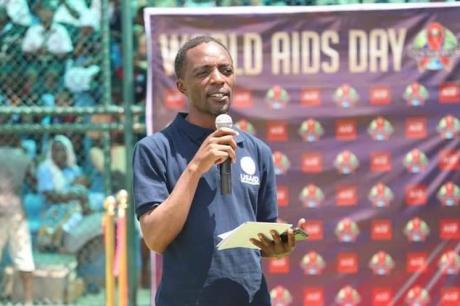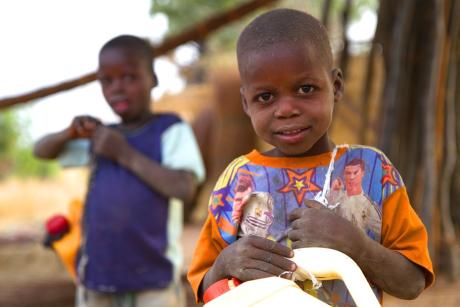
This human T cell (blue) is under attack by HIV (yellow), the virus that causes AIDS. Credit: Seth Pincus, Elizabeth Fischer and Austin Athman, National Institute of Allergy and Infectious Diseases, National Institutes of Health. Reprinted with permission under the Creative Commons License.
Published March 22, 2016, last updated on April 20, 2016 under Research News
One of the most crucial and elusive goals of an effective HIV vaccine is to stimulate antibodies that can attack the virus even as it relentlessly mutates.
Now a research team, led by investigators at the Duke Human Vaccine Institute—including medicine, immunology and global health professor Barton Haynes—and the Vaccine Research Center of the National Institute of Allergy and Infectious Diseases (NIAID), has tracked rare potent antibodies in an HIV-infected individual and determined sequential structures that point to how they developed.
The details form a blueprint that will help guide researchers as they try to build an experimental vaccine that recreates the pathway that gives rise to the important broadly neutralizing antibodies. The findings were recently reported in the journal Cell.
“We have followed a less potent neutralizing lineage in this particular individual before, but now we have found a far more potent antibody and have been able to study its development over six years,” said first author Mattia Bonsignori of the Duke Human Vaccine Institute. “With sequential structures, we can see the changes that occurred in both antibody and virus.”
The work was aided by the identification six years ago of a person in Africa whose HIV was diagnosed within weeks of infection and who provided blood samples to researchers periodically from the time of diagnosis, allowing researchers to examine in real time the co-evolution of the virus and the body’s immune response.
Using high-resolution electron microscopes and building structural models, the scientists were able to see the antibodies binding to the HIV envelope and the complicated structural changes that occurred in the antibody and the virus.
“We could visualize this complex dance between the virus and the antibody and understand exactly how the virus was teaching the antibody to be a broadly neutralizing antibody,” said Peter Kwong, chief of the Structural Biology Section at the NIAID Vaccine Research Center.
Kwong said understanding that interaction has been an important piece of the puzzle for vaccine development, because HIV mutates so rapidly. Broadly neutralizing HIV antibodies have been isolated from chronically infected people, giving HIV vaccine developers hope that they could stimulate production of such antibodies in healthy people as protection against the virus.
“Now we’ve been able to go back and see what happened,” Haynes said. “We hope we can recreate this pathway but because it is so tortuous, it will be difficult.”
Haynes said the research team’s insights would be tested in animal models. He said a second key to creating an effective vaccine is understanding how the body’s immune system often thwarts development of broadly neutralizing antibodies. Work to solve that is ongoing.
In addition to Haynes and Bonsignori, study authors from Duke include Feng Gao, Kevin Wiehe, S. Munir Alam, Todd Bradley, Morgan Gladden, Kwan-Ki Hwang, Sheelah Iyengar, Amit Kumar, Xiaozhi Lu, Kan Luo, Michael Mangiapani, Robert Parks, Hongshuo Song, David Montefiori, Michael Moody, Garnett Kelsoe, and Hua-Xin Liao.
The research received support from NIAID through the Center for HIV/AIDS Vaccine Immunology and Immunogen Discovery, the Scripps CHAVI-ID, and the Scripps HIVRAD. The International AIDS Vaccine Initiative also provided funds for the study.
This article was adapted from the original press release issued by Duke Health.
Using high-resolution electron microscopes and building structural models, the scientists were able to see the antibodies binding to the HIV envelope and the complicated structural changes that occurred in the antibody and the virus.


